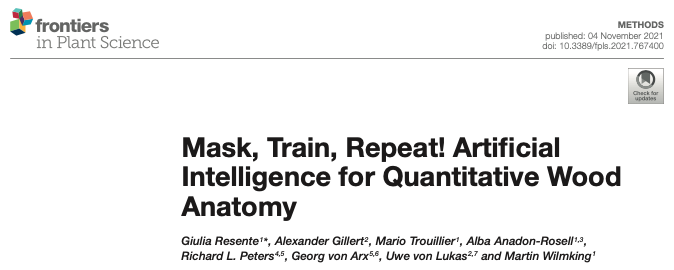QNET-Seminars
Nr. 3
December 14 2022 at 03:00 PM CEST
Mask, Train, Repeat! Artificial Intelligence for Quantitative Wood Anatomy.
Giulia Resente, Botany and Landscape Ecology Department, Greifswald University (GER)
Abstract: The recent developments in artificial intelligence have the potential to facilitate new research methods in ecology. Especially Deep Convolutional Neural Networks (DCNNs) have been shown to outperform other approaches in automatic image analyses. Here we apply a DCNN to facilitate quantitative wood anatomical (QWA) analyses, where the main challenges reside in the detection of a high number of cells, in the intrinsic variability of wood anatomical features, and in the sample quality. To properly classify and interpret features within the images, DCNNs need to undergo a training stage. We performed the training with images from transversal wood anatomical sections, together with manually created optimal outputs of the target cell areas. The target species included an example for the most common wood anatomical structures: four conifer species; a diffuse-porous species, black alder (Alnus glutinosa L.); a diffuse to semi-diffuse-porous species, European beech (Fagus sylvatica L.); and a ring-porous species, sessile oak (Quercus petraea Liebl.). The DCNN was created in Python with Pytorch, and relies on a Mask-RCNN architecture. The developed algorithm detects and segments cells, and provides information on the measurement accuracy. To evaluate the performance of this tool we compared our Mask-RCNN outputs with U-Net, a model architecture employed in a similar study, and with ROXAS, a program based on traditional image analysis techniques. First, we evaluated how many target cells were correctly recognized. Next, we assessed the cell measurement accuracy by evaluating the number of pixels that were correctly assigned to each target cell. Overall, the “learning process” defining artificial intelligence plays a key role in overcoming the issues that are usually manually solved in QWA analyses. Mask-RCNN is the model that better detects which are the features characterizing a target cell when these issues occur. In general, U-Net did not attain the other algorithms’ performance, while ROXAS performed best for conifers, and Mask-RCNN showed the highest accuracy in detecting target cells and segmenting lumen areas of angiosperms. Our research demonstrates that future software tools for QWA analyses would greatly benefit from using DCNNs, saving time during the analysis phase, and providing a flexible approach that allows model retraining.
Bio: Giulia is a PhD candidate at the University of Greifswald, at the Botany and Landscape Ecology department. Through her PhD experience, together with her working team she successfully developed an interface that allows for cells and ring recognition in microscopic images of different wood species. The aim of her research is to apply this newly developed tool to answer ecological questions. She has always had strong interest in wood and wood products. In particular she finds recognition of wood species, wood physics, mechanics, and acoustics very attractive.
Nr. 2
May 13 2022 at 02:00 PM CEST
Tree-ring anatomy revises the medieval temperature context for the current warming
Dr. Jesper Björklund, Swiss Federal Research Institute WSL, Switzerland
Abstract: Tree-ring data are central to the vast majority of empirical studies characterizing temperature change of the Common Era, and are thus subject to scientific critiques on their ability to capture key characteristics of historical variations. Here we present innovative and unprecedented tree-ring anatomy-based proxy data that mitigates many of the relevant limitations of the more commonly employed tree-ring width and wood density parameters. Our wood cell anatomical dimensions from Fennoscandian Pinus sylvestris trees explains >70% of the variance in regional warm season temperatures, captures both hot and cold extremes as well as inter-annual to centennial variation with high fidelity, and display rapidly recovering temperature sensitivity after occurrence of canopy damages. In contrast to prior tree ring wood density-based reconstructions, our new wood anatomical reconstruction reveal that the 20th century was warmer than any other in the past millennium, which is in agreement with corresponding CMIP5/PMIP3 climate model simulations. The enhanced proxy performance and revised millennium temperature context is thought to mainly be related to increased measurement precision, and being able to seek out the exact anatomical components which carry the purest representations of the climate signal.
Nr. 1
March 23 2022 at 02:00 PM CEST
Hydraulic trade-offs underlie local variation in tropical forest functional diversity and sensitivity to drought
Dr. Lourenço Jehova Jr., Exeter University, UK
Abstract: Tropical forests are important to the regulation of climate and the maintenance of biodiversity on Earth. However, these ecosystems are threatened by climate change, as temperatures rise and droughts’ frequency and duration increase. Xylem anatomical traits are an essential component in understanding and predicting forest responses to changes in water availability.
We calculated the community-weighted means and variances of xylem anatomical traits of hydraulic and structural importance (plot-level trait values weighted by species abundance) to assess their linkages to local adaptation and community assembly in response to varying soil water conditions in an environmentally diverse Brazilian Atlantic Forest habitat.
Scaling approaches revealed community-level trade-offs in xylem traits not observed at the species level. Towards drier sites, xylem structural reinforcement, and integration balanced against hydraulic efficiency and capacitance xylem traits, leading to changes in plant community diversity.
We show how general community assembly rules are reflected in persistent fiber–parenchyma and xylem hydraulic trade-offs. Trait variation across a moisture gradient is larger between species than within species and is realized mainly through changes in species composition and abundance, suggesting habitat specialization. Modeling efforts to predict tropical forest diversity and drought sensitivity may benefit from adding hydraulic architecture traits into the analysis.
Regular seminars series
LTRR tree-ring talks
Tree-Ring Talks are seminars held in the Multi-purpose Room at the Bannister Building typically either at lunchtimes or at the end of the day (but check the details of specific talks, as this schedule can vary). The topics are a selection that will be of interest to researchers and students at the Tree-Ring Lab, but the talks are open to anyone who is interested, whether they are associated with other University departments or are simply members of the general public.
International tree-mortality network
The International Tree Mortality Network is an initiative of the IUFRO task force on tree mortality. The network is hosting a series of online seminars in regular 6–8 week intervals
FLUXNET seminar series
The FLUXNET Seminar Series is a monthly community event co-sponsored by FLUXNET Early Career Network, AmeriFlux AMP, and members of the AmeriFlux and FLUXNET communities. The theme of the events will alternate between community and science, and data/tech seminars.
Birmensdorf tree-ring lectures
The Birmensdorf Tree-ring lectures are irregular seminars held at the Swiss Federal Research Institute for Forest, Snow and Landscape Research
Harvard Forest Seminars
Harvard Forest seminars are Thursdays at 11:00 a.m. Eastern Time, unless otherwise noted. They are presented online via Zoom. Seminars are free and open to the public; no pre-registration is required.
BES Ecology life
The British Ecological Society broadcast free online talks on the latest ecological research
Nutrient Cycles in Earth System Models
THe seminar series is based on 1.5 hours weekly Zoom meeting for 13 weeks, with a mix of presentations by invited speakers and collaborative discussions
Round of FORESTIA webinars
This seminar round is organized within the framework of the activities of the LIA FORESTIA (International Associated Laboratory FORESTIA) and the MiDi network with the support of the Studium.

